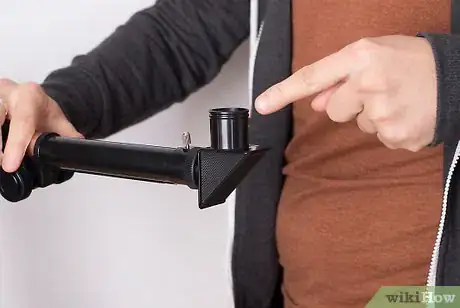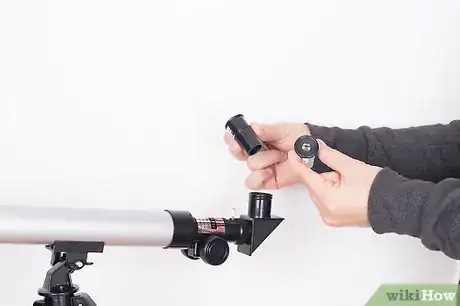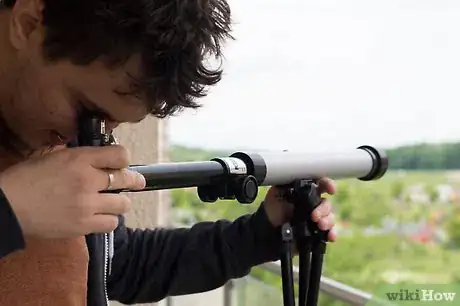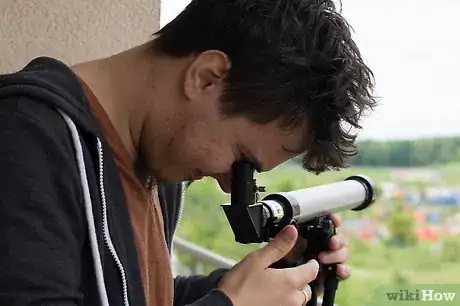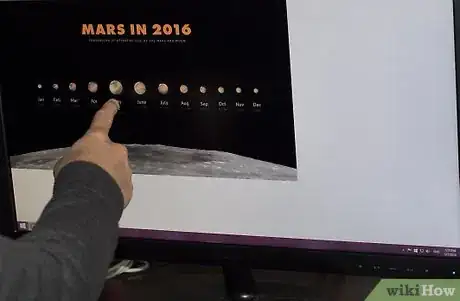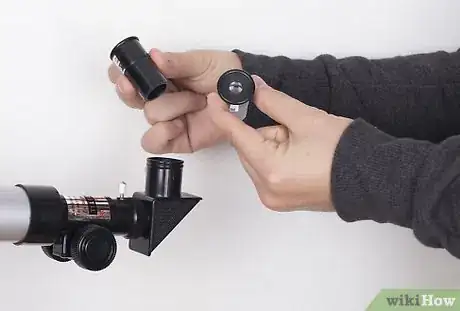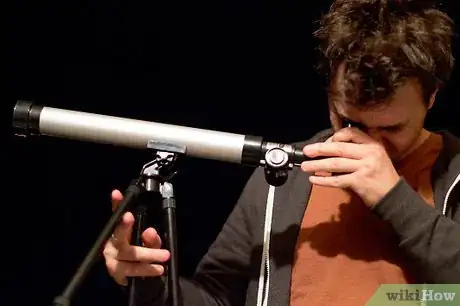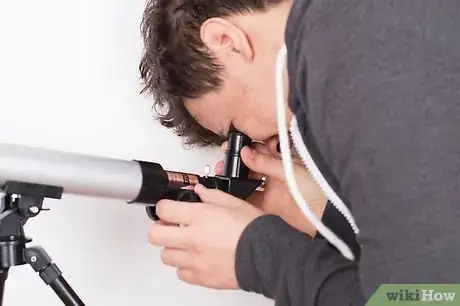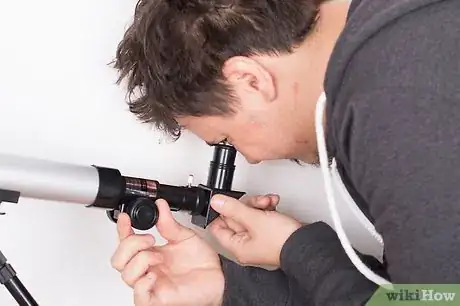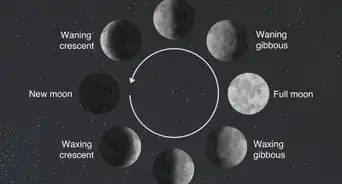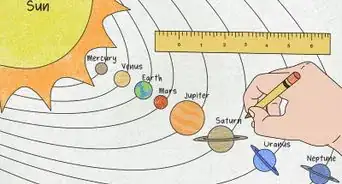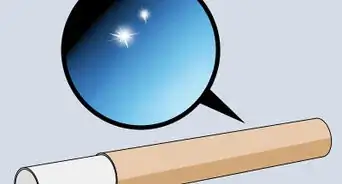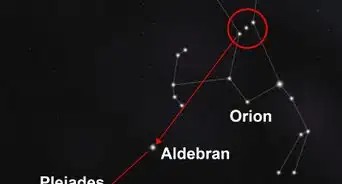This article was co-authored by wikiHow Staff. Our trained team of editors and researchers validate articles for accuracy and comprehensiveness. wikiHow's Content Management Team carefully monitors the work from our editorial staff to ensure that each article is backed by trusted research and meets our high quality standards.
This article has been viewed 67,192 times.
Learn more...
If you have an interest in astronomy, knowing how to use a telescope would be a great way to learn more about the night sky. Using a few simple tricks and aligning your finder with the telescope will allow you to find any visible planet in the night sky. Take a closer look at those stars and planets above you with this quick guide about focusing your telescope on planets.
Steps
Aligning the Finder
-
1Locate the finder on your telescope. The finder is usually a smaller tube that sticks off the side of the telescope. It has a wider viewing range, so it can be used to find small objects in the sky. It only works if it is properly aligned to the telescope itself.
- When you look through the finder, you should see crosshairs. After properly aligning the finder, you can center an object in these crosshairs and then look at it magnified in your telescope.
-
2Adjust the telescope eyepiece to the lowest magnification. The lowest magnification on the telescope has the widest range of view when looking through the eyepiece. On a smaller scope, the eyepiece will have a number written in millimeters, such as 20 mm or 25 mm. The higher numbers have the lowest magnification. Look at the eyepieces on your telescope and make sure the one with the lowest magnification is in place for viewing.Advertisement
-
3Focus the telescope on an object in the (near) distance. It is easiest to do this process during the day when you can more easily see many different objects in the distance, but it does not have to be day time. Choose a distant object such as your neighbor’s chimney or cell phone tower and find it in your telescope.
- If your telescope can lock in place, engage these locks to keep it from moving away from object you have found.
-
4Adjust the finder to center the large object in the crosshairs. Now that the telescope is focused on something, you want to move the finder until you see the exact same object centered in the crosshairs. Most finders will have screws on the side that will allow you to adjust its position. Once you have adjusted the finder, look back through it and make sure you still see the object centered in the crosshairs. Then, look through telescope and make sure it is still pointed at the object.
- If both views are of the object, you have successfully aligned your finder.
- The finder is easily jostled out of place, so you may need to repeat this process again if the telescope is moved or bumped.
Focusing on a Planet
-
1Look up star charts and planet guides for that month. Different planets are more or less visible depending on what time of year it is and where you are in the world. There are many websites and guides that will tell you what is visible for the month and location you are in. Use this as a guide to choose what you want to find.[1] ,[2]
- These guides will give you an idea of where to look in the sky to find the planet by eye.
-
2Adjust the telescope to its lowest magnification. Just as you did to align the finder, make sure the eyepiece with the lowest magnification is in place. Magnification on telescopes is measured in millimeters and the lowest will likely be around 20-25 mm.
- You want to adjust the magnification before you locate the planet in your finder because you could jostle the telescope out of position when making the change.
-
3Locate the planet in the telescope finder. Once you have found your planet of interest by eye, position the telescope so that it is pointing in that general direction. Look through the finder until you find the planet and center it in the crosshairs.
- Avoid jostling the finder out of place as you try to find your object. Move the telescope to adjust the finder’s position otherwise the finder position will no longer match up with the telescope.
-
4Find the planet through the telescope’s eyepiece. If the finder has been properly aligned with the telescope, you should be able to see the planet through the telescope eyepiece. You might need to move the telescope a little bit to see the planet, but it should be pretty close to where you focused with the finder.
- If you get too far away and still can’t find the planet through the telescope, make sure the planet is still visible in the finder. If it is and you can’t find it in the telescope, try realigning your finder.
-
5Sharpen the planet using the focus knobs. Using the knobs on the side, you can shorten or lengthen the distance between the eyepiece and lens of the telescope. Changing this distance allows you to focus on the object in question. Adjust the knobs until you see the image come into a sharp focus.
- Try changing the eyepiece to increase the magnification and refocus. You may find that while the image is larger, you cannot focus as well. For smaller home scopes, the more you increase the magnification, the lower your resolution of image will be. Smaller scopes just aren’t powerful enough to sharpen the focus of a highly magnified planet.
Community Q&A
-
QuestionWhere can I find coordinates to use with my telescope?
 Community AnswerThere's a lot of planetarium software available for computers, tablets, and phones. These programs can show you what's in the sky at a given location, date, and time. You can also look at star charts or planispheres. If you want fun objects to look at, consider looking into the Messier objects.
Community AnswerThere's a lot of planetarium software available for computers, tablets, and phones. These programs can show you what's in the sky at a given location, date, and time. You can also look at star charts or planispheres. If you want fun objects to look at, consider looking into the Messier objects. -
QuestionHow do I stop seeing the secondary spider when trying to focus on a planet?
 Community AnswerContinue to focus in whatever direction "shrinks" the object until it finally snaps into clear, sharp focus. Once that's done you will have focused "past" the spider and won't see it anymore.
Community AnswerContinue to focus in whatever direction "shrinks" the object until it finally snaps into clear, sharp focus. Once that's done you will have focused "past" the spider and won't see it anymore. -
QuestionI bought a telescope with 700mm focal length. I have 3 eyepieces 4mm,12.5mm, 20mm and a 1.5* erecting eyepiece and a 3* Barlow lens. What lenses should I use to get a clear vision of the moon?
 VISHNU GOKULCommunity AnswerYou can use the 20 mm lens, and if you want to get more details of the moon, use the 12.5 mm. To look at craters, you can use the 4 mm eyepiece.
VISHNU GOKULCommunity AnswerYou can use the 20 mm lens, and if you want to get more details of the moon, use the 12.5 mm. To look at craters, you can use the 4 mm eyepiece.
Warnings
- Never point your telescope at the sun!⧼thumbs_response⧽
